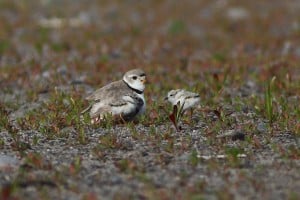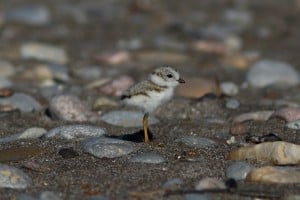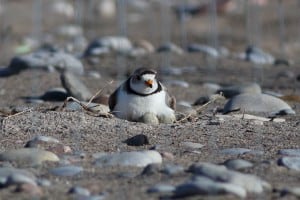MAY 17, 2016: “After a prior absence of 81 years, this is the second consecutive year that a
pair of Piping Plovers has initiated nesting on the Canadian shore of Lake
Ontario in the Greater Toronto Area. Yesterday, I confirmed that the female of
a pair of Piping Plovers present at Darlington Provincial Park for the past
week had laid their first egg in a nest there. The female bird from this pair
is banded and is known to originate from a nest in Michigan. The male bird is
also banded and is known to be one of the birds that fledged from a nest at
Wasaga Beach last summer.
The location of the nest has been shared with the recovery team for the Piping Plover of the Canadian Wildlife
Service and further protection of this nest (territory perimeter fencing,
do not enter signage, no dogs allowed signage, a predator exclosure, nest
surveillance, etc.) has already been established under the joint auspices of
the Canadian Wildlife Service, Ontario Ministry of Natural Resources and
Ontario Parks. The posted signage warns that fines may be charged for those who
do not obey the posted access restrictions.
Those wishing to come and view the birds are encouraged to do so, but please
also remember that this is one of the rarest breeding birds in Ontario, and
this Endangered Species is only now just trying to establish a new “beachhead”
on Lake Ontario, where continued success might serve to provide range extension
to other suitable beaches on Lake Ontario and Lake Erie. The nesting area on
the Darlington Beach is clearly cordoned off with a roped perimeter fence with
Piping Plover “Do Not Enter” signage. The predator exclosure over the nest is
about in the middle of the cordoned area. Observers are requested to view the
birds from outside the far west or east ends of the cordoned territory only. A
section of the south perimeter allows observers to walk along the shoreline,
but clear signage has been erected asking observers not to stop adjacent to the
exclosure for observations, but to use this merely as a passage to enable
access to both ends of the beach.
In an era when so many of our birds are
showing alarming declines, this is an enormously encouraging and novel
conservation success story being written one Ontario beach at a time.
Particularly after the unfortunate nest failure on Toronto’s Hanlan’s Point
last summer, let’s hope
that we can do everything possible to help ensure that this pair of Piping
Plovers has a successful nesting season here at Darlington in 2016.
Very soon, in conjunction with the local natural history clubs like the Durham
Region Field Naturalists and the Pickering Naturalists, a coordinated volunteer
Piping Plover stewardship group will be organized. Those interested in
volunteering time to monitor this nest are welcome to contact me [
glenn_co…@hotmail.com ] and I will introduce you to the plover watch
coordination team.
Darlington Provincial Park can be accessed by exiting Hwy 401 at exit 425
(Courtice Road) and taking Courtice Road south to the first right turn (west)
onto Darlington Park Road where you can follow the signs to the provincial park
entrance gate. Upon entrance to the park, follow the signage from here to the
beach on Lake Ontario at the southeast corner of McLaughlin Bay.
Glenn Coady, Ontbirds
Whitby
UPDATES
JUNE 22: “I’ve been to Darlington several times to see the nesting Piping Plovers. One nest produced 4 chicks on June 17 or 18. One is lost, the other 3 are very active. Roaming about without too much parental supervision at times – including their first trip to the water’s edge on their own. When danger threatens the parents call and the chicks either shelter beneath one parent or freeze on the spot and squat low. The other nest is still in process. I got a few shots showing a bird on the next with two of four eggs visible, 2 chicks hiding with mom, and a couple of chick shots.
JULY 2: “The young in the first nest were banded a couple of days ago at age 14 days or so and will be flying in another two weeks. They still have some down and need feathers to fly. They are half the size of the adults. They roam the beach from the first nest area down to the 2nd nest. The 2nd nest hatched 4 young about 2 days ago. The young are at the ball of fluff stage. They roam the 2nd nest area. The male from the 2nd nest area appears to have disappeared 2 days ago. The mom is on her own with 4 young. There are 20 or more Piping Plover chicks at Wasaga beach and one nest I believe at Presquile Provincial Park. They are not reporting any more on Ont Birds because they don’t want too many people showing up.”
Greg Piasetzki, Toronto


